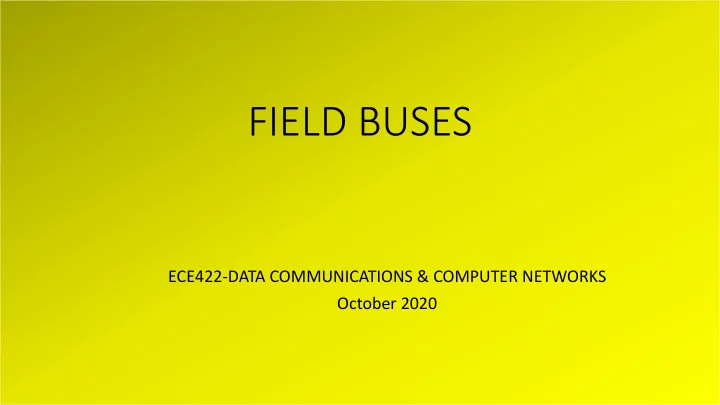

FIELD BUSES ECE422-DATA COMMUNICATIONS & COMPUTER NETWORKS October 2020
WHAT IS A FIELDBUS? 1. Fieldbus is a digital communication bus line connecting the field instruments with the control system components. 2. A field instrument is an instrument attached to a process, e.g.: measurement devices, valves, motor starters and alarm switches . 3. A field instrument to be attached to a fieldbus must be equipped with some intelligence for the bus communication. 4. Without fieldbus, each field instrument has to be connected to the I/O of the control system, two wires for each instrument
BENEFITS OF USING FIELDBUS The benefits of using fieldbuses are: • Reduction of cables resulting in savings in cost and weight and a tidier system without the mess that a multi-cabling system gives. • fieldbus systems have less hardware components. • Easier to maintain and configure. • Interoperability: Fieldbus instruments from different vendors can communicate directly on the same bus. • A field instrument can easily be changed with another during run time
FIELDBUS STANDARDS 1. In year 2000 International standardization organizations (ISO) developed the IECC 61158 standard, which includes 8 different fieldbuses in the same standard. 2. The 8 fieldbuses included in this Octobus standard are: a) PROFIBUS b) ControlNet c) FF – H1 (Foundation Fieldbus) d) FF – HSE (Foundation Fieldbus) e) Interbus f) P-Net g) SwiftNet h) WorldFip •
PROFIBUS • PROFIBUS is a short form for PROcess FIeldBUS and is a vendor- independent, open fieldbus standard. • PROFIBUS is the world's most successful fieldbus with 70 million devices installed by the end of 2019 with almost 10 million of these in the process industries. • Utilizing a single, standardized, application-independent communication protocol, PROFIBUS supports fieldbus solutions both in factory and process automation as well as in motion control and safety-related tasks.
HISTORY OF PROFIBUS 1. PROFIBUS was developed in 1990 in Germany as a joint project between Siemens, Klöckner Möller (now Moeller Electric), and Bosch. 2. In 1991 it was taken in as a part of the German standard (DIN 19245) and became later a European standard (EN 50170). 3. PROFIBUS is now part of the new ISO Octobus standard IEC 61158.
PROFIBUS PROFILES PROFIBUS has three types of profiles: 1. Station types: Application Profiles (PA-devices, Encoders, Drivers, ..) 2. Protocols: Communication Profiles ( DP, FMS, TCP/IP) 3. Signal transmission: Physical layer signals (RS-485, IEC1158-2, O.F., Ethernet)
PROFIBUS ARCHITECTURE
PROFUBUS PHYSICAL MEDIUM-CABLE The RS 485 transmission is the transmission technology most used on PROFIBUS. Its main characteristics are: 1. NRZ Asynchronous Transmission; 2. 9.6 kBit/s to 12 Mbit/s configurable baud rates; 3. Twisted pair shielded cable; 4. 32 stations per segment, 127 stations max; 5. Distance dependent on the transmission rate 12 MBit/s = 100 m; 1.5 MBit/s = 400m; < 187.5 kBit/s = 1000 m; 6. Expansible distance up to 10 Km with the use of repeaters; 7. 9 PIN, D-Sub connector.
TRANSMISSION OVER COPPER CABLE The transmission technology is synchronous with Manchester codification in 31.25 Kbits/s (voltage mode); it is defined according to the IEC 61158-2 and was elaborated aiming to satisfy the requisites by chemical and petrochemical industries: intrinsic safety and the possibility of power the field equipment through the bus. CHARACTERISTICS PHYSICAL MEDIUM COMPLYING WITH IEC61158-2, H1 VARIANT Cable 31.25 kbits/s Topology Bus, tree, point to point. Power Supply Via bus or external medium Intrinsic Safety Possible Number of equipments Maximum 32( non-Ex ) (depends on current devices Explosion Group IIC: 9 consumption) Explosion Group IIB: 23 Maximum Cabling 1900 m, expansible to 10 Km with 4 repeaters. Spur Maximum 120m/spur Communication Signal Codification, with voltage modulation
TRANSMISSION OVER FIBRE OPTICLE CABLE
Recommend
More recommend